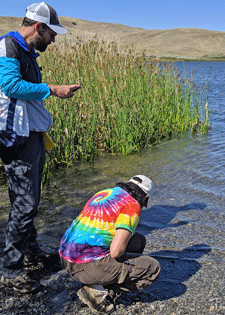Assessing contaminant distributions and sources in Castaic Lake
Summary:
Castaic Lake, located outside of Los Angeles, California is the third-largest water storage facility associated with the California State Water Project and is regularly utilized for fishing and recreation. It is also one of 131 California reservoirs listed as impaired due to mercury concentrations in fish. This study aims to identify primary sources of mercury to the lake and to provide a baseline of water quality data for comparison to future conditions.
Investigators:
Priya Ganguli
Assistant Professor, Geological Science
California State University, Northridge
Scott Hauswirth
Assistant Professor, Geological Science
California State University, Northridge
Project description:
Castaic Lake, located outside Los Angeles, is the third-largest water storage facility associated with the California State Water Project and is regularly utilized for fishing and recreation. It is also one of 131 California reservoirs listed as impaired due to mercury concentrations in fish. Despite the existing fish consumption advisory, no studies investigating water quality in Castaic Lake have been published in the peer-reviewed literature. We will, therefore, evaluate potential sources of bioaccumulative organic monomethylmercury (MeHg) within the reservoir’s water column and watershed.
Inorganic mercury is transformed into MeHg by anaerobic bacteria that live in low oxygen environments, such as in the sediment or water column of lakes and human-made reservoirs. Castaic Lake anoxic bottom waters may therefore be a key source of biologically available mercury in this system. In addition to mercury-impacts, Castaic Lake is increasingly threatened by Southern California wildfires. We are therefore expanding our mercury study to incorporate analyses for polycyclic aromatic hydrocarbons (PAHs) and heavy metals (e.g., Pb, As, Cd), both of which can be elevated in runoff from wildfire-impacted landscapes.
The primary objectives of this study are to identify the primary source(s) of MeHg to Castaic Lake; provide a baseline profile of the concentration and distribution of mercury species, metals, PAHs, and nutrients in Castaic Lake for comparison to future climate conditions; assess seasonal variability in Hg biogeochemical cycling in the lake; and provide meaningful environmental data to California resource agencies.
We hypothesize that mercury production within the water column is the primary source of organic mercury to Castaic Lake, with inputs from lake tributaries being the primary source of inorganic mercury. This study will be a first step toward evaluating the importance of in situ sources of organic mercury versus watershed and atmospheric inputs in a West Coast reservoir. It provides a baseline for mercury levels within Castaic Lake and contributes to our understanding of climate change impacts on reservoir systems.



